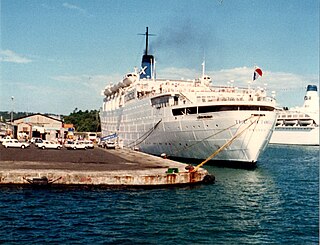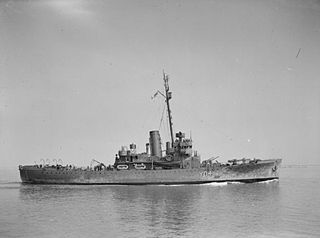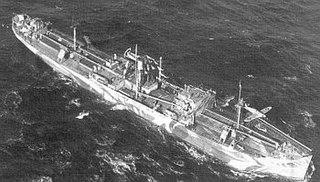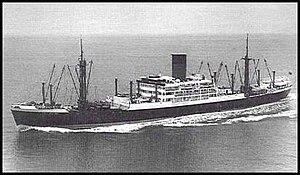
HMS Battler (D18) was an American-built escort carrier that served with the Royal Navy during the Second World War.

HMS Attacker (D02) was an American-built escort carrier that served with the Royal Navy during the Second World War.

HMS Chaser (D32/R306/A727) was an American-built Attacker-class escort carrier that served with the Royal Navy during the Second World War.

USS Jamaica (CVE-43), was an escort carrier of World War II that served in the British Royal Navy as HMS Shah (D21). Returned to the United States at war's end, she was converted into a merchant vessel and she was sold into civilian service in 1946 as Salta. She was ultimately scrapped in 1966.

811 Naval Air Squadron was a unit of the British Royal Navy's Fleet Air Arm. It was first founded in 1933, and served during World War II, seeing action in the battle of the Atlantic and on Russian convoys, and was eventually disbanded in 1956.

USCGC Itasca was a Lake-class cutter of the United States Coast Guard launched on 16 November 1929 and commissioned 12 July 1930. It acted as "picket ship" supporting Amelia Earhart's 1937 world flight attempt, and was the last vessel in radio contact with her as she was supposed to be reaching Howland island in the Pacific. In 1941, it was transferred to the United Kingdom and served as a convoy escort in World War II as HMS Gorleston.

MS Dunnottar Castle was a British-built passenger ship with a career of more than six decades that included periods as an ocean liner, an armed merchant cruiser (AMC), a troop ship and several decades as a cruise ship. As a cruise ship she was renamed Victoria, then The Victoria and finally Princesa Victoria.

The Shoreham-class sloops were a class of eight warships of the Royal Navy built in the early 1930s.

HMS Nairana was the lead ship of the Royal Navy's Nairana-class escort carriers that saw service in the Second World War. She was built at John Brown & Company shipyards in Clydebank, Scotland. When construction started in 1941 she was intended as a merchant ship, but was completed and launched as an escort carrier, entering service at the end of 1943.

The Nairana-class escort carrier was a British-built class of three escort carriers. They were constructed one each in England, Scotland and Northern Ireland to the same basic design during the Second World War for service with the Royal Navy.

The Banff-class sloop was a group of ten warships of the Royal Navy. Built as United States Coast Guard Lake-class cutters, in 1941 these ships were loaned to the Royal Navy as antisubmarine warfare escort ships. The transfers took place at the Brooklyn Navy Yard; the sloops were manned for transport to Britain by personnel from the damaged battleship Malaya which was under repair there.

Empire Darwin was a British 6,765 GRT CAM ship built in 1941 by William Gray & Co. Ltd., West Hartlepool, United Kingdom for the Ministry of War Transport (MoWT). Her Hawker Sea Hurricane was involved in the last action by an aircraft flown off a CAM ship, shooting down a Focke-Wulf Fw 200 Condor on 28 July 1943.

The second HMS Essington (K353), and the first ship of the name to see service, was a British Captain-class frigate of the Royal Navy in commission during World War II. Originally constructed as a United States Navy Buckley-class destroyer escort, she served in the Royal Navy from 1943 to 1945.

HMS Watchman was a W-class destroyer of the British Royal Navy that saw service in the final months of World War I, in the Russian Civil War, and in World War II.

HMS Whitehall, pennant number D94, later I94, was a Modified W-class destroyer of the British Royal Navy that saw service in the Second World War.

Fort Stikine was a British Fort ship which was built in Canada in 1942. Owned by the American War Shipping Administration, she was leased under charter to the Ministry of War Transport under the Lend-Lease scheme and operated under the management of the Port Line. Fort Stikine only had a short career, and was destroyed in an explosion at Bombay, India, in April 1944 that caused the loss of a further thirteen ships.

USS LST-21 was a United States Navy LST-1-class tank landing ship used primarily in the Europe–Africa–Middle East Theater during World War II, but also transported British forces from Calcutta and landed them at Regu Beach, Burma.

SL convoys were a numbered series of North Atlantic trade convoys during the Second World War. Merchant ships carrying commodities bound to the British Isles from South America, Africa, and the Indian Ocean traveled independently to Freetown, Sierra Leone to be convoyed for the last leg of their voyage to Liverpool.

The Gibraltar convoys of World War II were oceangoing trade convoys of merchant ships sailing between Gibraltar and the United Kingdom. Gibraltar convoy routes crossed U-boat transit routes from French Atlantic ports and were within range of Axis maritime patrol aircraft making these convoys vulnerable to observation and interception by bombers, submarines, and surface warships during the Battle of the Atlantic. OG convoys brought supplies from the United Kingdom to Gibraltar from September 1939 until September 1942. Beginning with Operation Torch, OG convoys were replaced by KM convoys transporting military personnel and supplies from the United Kingdom to and past Gibraltar into the Mediterranean Sea. HG convoys brought food, raw materials, and later empty ships from Gibraltar to the United Kingdom from September 1939 until September 1942. After Operation Torch, HG convoys were replaced by MK convoys returning mostly empty ships from the Mediterranean to the United Kingdom. KM and MK convoys ended in 1945.

HMS Dart (K21) was a River-class frigate of the Royal Navy. Dart was built to the RN's specifications as a Group I River-class frigate.




















